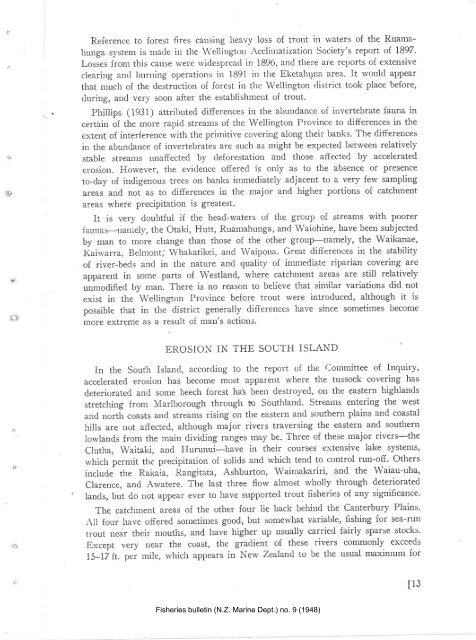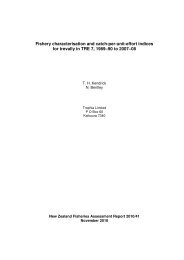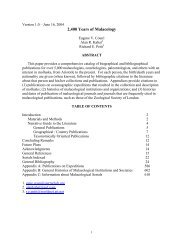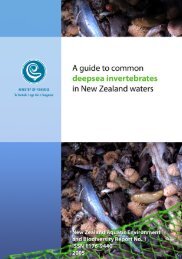N.Z. MARINE DEPARTMENT-FISHERIE,S BULLETIN No. .į
N.Z. MARINE DEPARTMENT-FISHERIE,S BULLETIN No. .į
N.Z. MARINE DEPARTMENT-FISHERIE,S BULLETIN No. .į
You also want an ePaper? Increase the reach of your titles
YUMPU automatically turns print PDFs into web optimized ePapers that Google loves.
Reference to forest fires causing heavy loss of trout in waters of the Ruamahunga<br />
system is macle in the Wellirrgtou Acclirìlatization Society's rePort of 1897.<br />
Losses from this cause lvere rvidespreacl in 189ó, ancl there are rePorts of extensive<br />
clearing ancl burning operations in 1891 in the Eketahuna area. It woulcl aPpear<br />
that much of the destruction of forest ir-r the Wellington clisttict took place before,<br />
during, and very soon after the establishtnent of trout.<br />
Phillips (1931) attributed differences in the abundance of invertebrate fauna in<br />
certain of the more rapid strearns of the Wellington Province to differences in the<br />
extent of interference rvith the primitive covering along their banks. The differences<br />
in the abunclance of invertebrates are such as might be expected between relatively<br />
stable streams unaftectecl by cleforestation ancl those affected by accelerated<br />
erosion. However, the eviclence offerecl is only as to the absence of pfesence<br />
to-clay of indigenous trees on banks immediately adjacent to a very few sampling<br />
areas a¡cl not as to differences in- the major and higher portions of catchment<br />
areas where precipitation is greatest.<br />
It is very doubtful if the head-waters of the group of streams with poorer<br />
f¿¡n¿5-11¿11-1ely, the Otaki, Hutt, Ruamahunga, and \Maiohine, have been subjected<br />
by man to mofe change than those of the other group-namely, the Waikanae,<br />
I(aitvarra, Belmont," Whakatikei, and Waipoua. Great differences in the stability<br />
of river-beds and in the nature and quality of imrnediate riparian covering are<br />
apparent in some parts of Westland, where catchment areas are still relatively<br />
unmodifred by man. There is no reason to believe that similar variations did not<br />
exist in the Wellington Province before trout were introduced, although it is<br />
possible that in the district generally differences have since sometimes become<br />
more extreme as a result of man's actions.<br />
EROSIOT{ IN T}IE SOUTH ISLAND<br />
In the South Islancl, according to the report of the liommittee of Inquiry,<br />
acceleratecl erosion has become most apparent where the tussock covering has<br />
deterioratecl aucl sotue beech forest ha\ been destroyed, on the eastefn highlands<br />
stretching from Mar'lborough through ûo Southland. Streams entering the west<br />
ancl ¡ortñ coasts ancl streams rising on the eastern and southern plains and coastal<br />
hills are not affected., although rnajor rivets traversing the eastern and southern<br />
lowlands from the main dividing ranges rnay be' Three of these major rivèrs-the<br />
Clutha, Waitaki, and Hurunui-have in their courses extensive lake systems,<br />
which permit the precipitation of solids and which tend to control run-off. Others<br />
include the Rai







